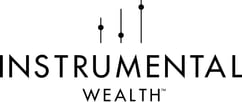Q2 2024 Review: Market & Economic Commentary
Check out our Q2 2024 Review: Market & Economic Commentary with Chief Investment Officer Matthew Harbert, CFA from Instrumental Wealth.
Play the video recording, or see the takeaways for each section below organized by section & topic. Each topic has screenshots from the presentation.
Table of Contents:
- Investment Markets (0:22)
- Broad equity markets
- Expanded markets
- Sector review
- Driver of U.S. large cap performance
- Concentration
- Earnings growth
- Share of global market capitalization
- U.S. Economy (7:31)
- Key Takeaways (20:00)
- Employment
- Consumer spending
- Inflation
- Fed policy
- GDP growth and probability of a U.S. recession
Investment Markets (0:22)
All graphs and charts are for illustrative purposes only.
In this section, Matthew discusses the state of the Investment Markets in Q2 of 2024, reviewing broad equity and expanded markets, sectors, what's driving U.S. large cap performance, earnings growth, and the share of global market capitalization.
- In Q2, U.S. large caps showed slower but steady positive growth, while small caps turned negative, becoming the worst performers.
- Emerging markets were the top-performing broad equity category in Q2, outperforming U.S. equities, which is a significant shift from previous years.
- U.S. growth continues to be the top-performing asset class for both Q2 and year-to-date, while fixed income remains the worst-performing asset class for the year.
- The "Magnificent 7" stocks (particularly Nvidia, Alphabet, and Microsoft) have been driving a large portion of the S&P 500's gains, accounting for 64% of its market cap growth in the first half of 2024.
- The concentration of the top 10 stocks in the S&P 500 has increased significantly, now reaching close to 40% of the index.
- Earnings growth forecasts suggest that the earnings gap between the Magnificent 7 and the rest of the S&P 500 companies is expected to narrow by the end of the year.
- The U.S. market's strong performance and a strong dollar have increased its representation in global market indexes, growing from about 40% of the ACWI (All Country World Index) in 2010 to 64% currently.
U.S. Economy (7:31)
All graphs and charts are for illustrative purposes only.
In this section, Matthew discusses the state of the U.S. Economy in Q2 of 2024, reviewing employment reports, U.S. consumer spending, an update on inflation, Fed policy, overall economic growth, and the possibility of a recession.
- Employment remains elevated but is normalizing. The U.S. added an average of 177,000 jobs per month in Q2 2024, which is robust compared to pre-pandemic levels.
- The unemployment rate has risen to 4.1% from a low of 3.4% last year, but it's still below the 10-year average of 4.77%.
- Consumer spending has been resilient but showed a slowdown in the recent quarter. Retail sales were flat in June.
- Consumer spending has been supported by increased use of revolving credit (primarily credit cards) and a decrease in the savings rate since mid-2021.
- Delinquency rates for both credit cards and auto loans have been rising, indicating some financial stress, particularly among lower-income earners.
- Inflation, after rising in Q1, resumed its downward trend in Q2. Core commodities saw overall deflation, while core services, particularly in the shelter category, have started to show signs of cooling.
- The Federal Reserve completed its hiking cycle in July 2023, leaving the target range at 5.25% to 5.5%. Market expectations for rate cuts have shifted from early 2024 to later in the year.
- GDP growth has been cooling, with Q1 2024 showing the lowest growth rate (1.4% annualized) since June 2022. This slowdown is primarily driven by a decrease in consumption.
- Various recession indicators are mixed but generally signaling caution rather than an outright recession. The yield curve remains inverted, but other indicators like the LEI index have improved.
- The U.S. economy is considered to be entering the late stage of the business cycle, but there's still room for growth before a potential recession.
Key Takeaways (20:00)
All graphs and charts are for illustrative purposes only.
In this section, Matthew shares his Q2 2024 overall takeaways for Employment, consumer spending, inflation, fed policy, GDP growth and probability of a U.S. recession.
Employment
- Labor Markets continue to normalize but have not softened completely
- Robust number of new jobs added monthly
- Unemployment has risen but still historically low
Consumer Spending
- Holding up but cooling
- Higher interest rates are starting to impact the consumer as credit card default rates are rising
Inflation
- After an unwelcome surprise of higher prices in the 1st quarter, the downward trend has resumed
- Finally seeing some relief in the shelter categories
Fed Policy
- With normalizing of the labor markets, consumption slowing down, falling inflation trend and the economy overall cooling, we believe the Fed should be getting closer to the confidence they need to start easing
- We believe that we shouldn’t expect a cut in July, high probability of a cut in September
GDP Growth and Probability of a U.S. recession
- GDP growth seeing effects from higher interest rates
- Slowdown due to falling personal consumption
- Recent projections have looked better with 2.7% forecast for 2nd quarter growth
- Recession is not the highest probability in the near future, it’s looking more like a soft landing may occur
- Indicators reflect softening of the economy, however they are firmly in the cautious territory
- The U.S. is in the “early” late stage leaving room for growth to continue for a while
Markets
- U.S. Growth equities continue to outperform
- Concentration in U.S. large caps remains a problem and has risen over the 2nd quarter
- Earnings growth between top 10 holdings and remaining companies in the S&P 500 are expected to be in line by the end of the year. This suggests a broadening may start occurring
- Concentration is also rising internationally as the dollar and outsized domestic performance have driven up U.S. exposure in global indexes
Not an offer: This document does not constitute advice or a recommendation or offer to sell or a solicitation to deal in any security or financial product. It is provided for information purposes only and on the understanding that the recipient has sufficient knowledge and experience to be able to understand and make their own evaluation of the proposals and services described herein, any risks associated therewith and any related legal, tax, accounting or other material considerations. To the extent that the reader has any questions regarding the applicability of any specific issue discussed above to their specific portfolio or situation, prospective investors are encouraged to contact Instrumental Wealth or consult with the professional advisor of their choosing.Forward-looking statements: Certain information contained herein constitutes “forward-looking statements,” which can be identified by the use of forward-looking terminology such as “may,” “will,” “should,” “expect,” “anticipate,” “project,” “estimate,” “intend,” “continue,” or “believe,” or the negatives thereof or other variations thereon or comparable terminology. Due to various risks and uncertainties, actual events, results or actual performance may differ materially from those reflected or contemplated in such forward-looking statements. Nothing contained herein may be relied upon as a guarantee, promise, assurance or a representation as to the future.Past Performance: There is no guarantee that the investment objectives will be achieved. Moreover, the past performance is not a guarantee or indicator of future results.
Certain information contained herein has been obtained from third party sources and such information has not been independently verified by Instrumental Wealth LLC. No representation, warranty, or undertaking, expressed or implied, is given to the accuracy or completeness of such information by Instrumental Wealth LLC. or any other person. While such sources are believed to be reliable, Instrumental Wealth LLC. does not assume any responsibility for the accuracy or completeness of such information. Instrumental Wealth LLC. does not undertake any obligation to update the information contained herein as of any future date.
Instrumental Wealth, LLC (“Instrumental Wealth”) is an SEC registered investment adviser located in Florida. Registration does not imply a certain level of skill or training. Instrumental Wealth may only transact business in those states in which it is notice filed or qualifies for an exemption from notice filing requirements. Information about Instrumental Wealth (inculcating its services, fees, and registration status) is available on the SEC’s IAPD website at www.adviserinfo.sec.gov. There is no guarantee that the views and opinions expressed in this presentation will come to pass. Advisory services are only offered to clients or prospective clients where Instrumental Wealth and its representatives are properly licensed or exempt from licensure. Past performance is no guarantee of future returns. Investing involves risk and possible loss of principal capital. No advice may be rendered by Instrumental Wealth unless a client service agreement is in place.

